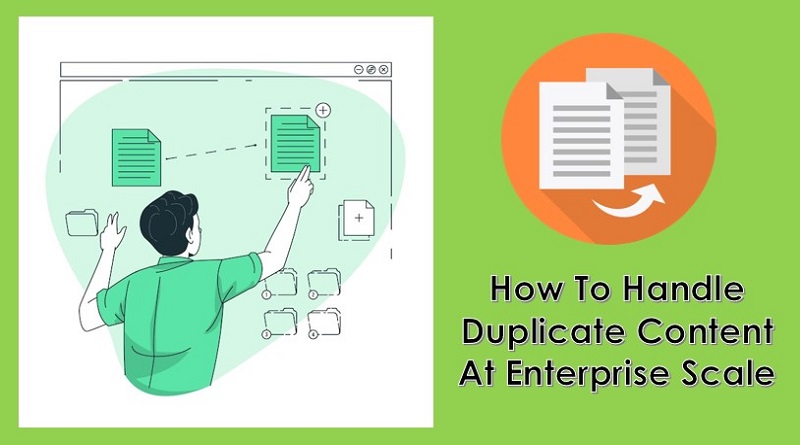Reinventing Web Design: Grapes Studio Lets Small Businesses Build Sites in Minutes
How To Handle Duplicate Content At Enterprise Scale

Minimize duplicate content on enterprise-level sites. Here are 7 tips for using dynamic, technical, and copy-based scaling strategies. Duplicate content can be a barrier to SEO performance and can prevent your search strategy from reaching specific goals. It’s also not helpful to searchers, which results in search engines like Google identifying other content as the better answer. Search engines can filter out pages from top search results and include certain pages that might not be the desired page to be ranked prominently for your site, as well. Duplicate content doesn’t necessarily mean that someone has stolen or copied your content without permission (although that does happen). At the enterprise level, you may have dealers, affiliates, or others who sell your products using your content. Sites that are part of the same corporate model, or feature products or services from the same creator or manufacturer, may have content that is the same as yours. Even if you aren’t doing anything spammy or malicious, you need a strategy for handling duplicate content inside your site and related to other sites. With an enterprise site, you don’t have the luxury of just updating a page or two or writing some custom tags to resolve the issues. Enterprise sites with the complexity of potentially thousands of pages, products, services, locations, or regulated content have several challenges. The good news is that there are specific ways to handle duplicate content at an enterprise scale.
7 Ways To Treat Enterprise Duplicate Content
- Guidelines For Content Use
- Auditing
- Dynamic Variable Tags
- Evaluate Global Template Content
- Scalable Copy
- User-Generated Content
1. Guidelines For Content Use
If you own or create content and have others that sell, feature, or license your products or services, you need to exert as much control as possible over the use of the content. You’ll likely allow dealers, vendors, and affiliates to use descriptions and details to maintain brand integrity. However, for your site to maintain the most authority and rankings, you need policies on what content can be used and what can’t. And, in some circumstances, you’ll need rules or guidelines on attribution. Doing everything to minimize content that you intended to be part of the parent brand’s unique content from being “borrowed” or used is important. That doesn’t mean others can’t use it, but be clear in what is free use, what requires attribution, and anything off-limits.
2. Auditing
Know what content on your site is duplicated from page to page and elsewhere on the web. There are several great tools for detecting and reporting duplicate content within SEO tool suites and standalone tools like Copyscape. Get into a regular process and routine of internal site audits as well as web audits for duplicate content so you can find anything new. That allows you to determine any uses (per the point above) that aren’t authorized to try to manage or navigate.
3. Dynamic Variable Tags
Enterprise-level sites often have thousands of pages. They don’t lend themselves to manual title tags, meta descriptions, and heading tags. Even if they did, it would take quite an effort to write, monitor, and document the tags to make sure they don’t contain duplication. For large eCommerce sites, lead gen sites, and brand sites that have products, blog posts, tech specs, and large sections and databases of user-facing content, it is important to create a dynamic set of tags. In the old days, this meant an SEO working with a developer to write formulas for tags to build based on database information. Most current sites have content management systems allowing tags to have dynamic variables and syntax. Use dynamic tagging and the variables to your advantage to scale the content of tags and headings to ensure they are custom and are as relevant and specific as possible for the page content.
4. Evaluate Global Template Content
The more header, footer, and other global page content, including navigation and sub-navigation that you have on every page, the more unique body content you’re going to need. This is important if you’re working toward a best practice of having no more than 20% plus or minus duplicate content per page. This is especially important on pages that don’t have a lot of copy or aren’t long-form content pages. Header copy, text in links, and footer copy that is the same on every page or within specific sections or content types are forgotten. If you don’t have to spell out every link on every page in a mega menu, don’t. If you don’t have to have a massive disclaimer on every single page footer, don’t. Look for ways to minimize global content and know that if you have to have a lot of it, you will need to have more body content to offset it.
5. Scalable Copy
This can be the most challenging enterprise duplicate content remedy or prevention method. A scaling copy can be time-intensive and difficult. Get stakeholders on board, and if you can do it, I strongly recommend it. I worked with a restaurant chain that had about 100 locations nationwide and it took some time and effort, but we were able to get to a point where every restaurant’s page on the site was at least 80% unique content. Beyond that, we were able to expand the pages into sections of unique content. That was a game-changer and helped us achieve top rankings in local and traditional searches across markets. We could even compete with several restaurants in the same market, stacking rankings at the top and avoiding Google filtering. If possible, work with content creators, franchisees, copywriters, UX designers, and developers to creatively find ways to craft unique copy and content for each location. When it comes to products and eCommerce – start with categories or product lines to prove the value. Use dynamic content blocks (similar to dynamic tags noted earlier) to factor in more detailed copy per page as products get more specific and technical.
6. User-Generated Content
Going beyond scaling content within internal resources, I recommend looking for ways to incorporate user-generated content as well. This can include pulling in reviews (if rendered as content on the page), testimonials, FAQs, forums, and other content that helps offset duplicate content from page to page, as well as provide new, unique copy about the subject matter of that specific page topic. This can create an opportunity for scale with fewer internal resources as long as there isn’t a heavy need for moderation, legal review, and other gatekeeping steps that put a burden on the enterprise-level operations.
7. Canonical Tags
Sometimes the last resort and sometimes the first line of action, canonical tags can be a great solution for enterprise sites handling duplicate content. However, they require a more advanced understanding of their use and the risks associated with improper logic and implementation. Canonical tags should be a standard for any situations where pagination occurs (as opposed to lazy-loading, AJAX, and infinite scrolling situations – which can still include canonical use and have their risks with indexing). In any situation where you intentionally have duplicate content within your site, use canonical tags to point to the page you care the most about getting ranked prominently. This is your way to aggregate link value and visibility for one page by being clear about your duplicate content situation. Having one page prominently ranked versus the wrong one (that you don’t want) or none is an advantage. When it comes to pages on other sites – you can also link back to the original across domains to ensure the proper credit and attribution are given. Even if you can’t get the canonical implementation, at least try to get a link back to the source as attribution.
Conclusion
Content management and strategy on an enterprise site have unique challenges with the scale, size, and scope of related companies or entities allowed to use the same copy or have relationships that aren’t always possible to manage. Using dynamic, technical, and copy-based scaling strategies, you can minimize the amount of duplicate content or manage it in ways that give you control of the situation and pages that receive value.




